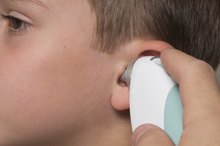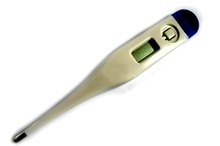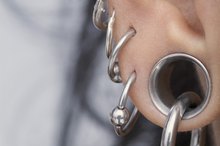How to Tell if a Thermometer Is Mercury
Thermometers can be used in a variety of applications and come in a variety of styles. They are often used for measuring body temperature, air temperature, or liquids used in cooking and candy-making. These common thermometers look like slender glass vials, usually several inches long, with a bulb at one end. The bulb senses temperature, while the sides of the vial provide a scale for measuring the temperature in degrees Celsius or Fahrenheit. Distinguishing between different types of thermometers is straightforward and usually does not require any tools.
Remove the case around the thermometer so that you can see the thermometer's bulb and vial. To view the temperature-sensing element of a thermostat, lift off the faceplate.
Safety 1st Ear Thermometer Instructions
Learn More
Look at the thermometer. If the bulb and vial are filled with a silver, metallic liquid, you have a mercury thermometer 2. While accurate, the mercury inside the thermometer is very dangerous if it comes in contact with skin 2. Take care in handling the thermometer so that it does not crack or break.
Check if your thermometer is filled with a red-tinted fluid. This type of thermometer uses alcohol, not mercury, to sense temperature 2. These types of thermometers are safer because if the glass vial breaks, the alcohol will simply evaporate and will not cause any harm.
How to Troubleshoot a Vicks Comfort Flex Thermometer
Learn More
See if your thermometer has a dial. Many thermometers that use a dial, such as candy thermometers, use a metal spring that is sensitive to heat. As the metal heats and expands, the spring slowly unwinds, driving the dial or arrow attached to one end of a spring. A thermometer that registers temperature with a round dial uses this type of mechanism.
See if your thermometer has a digital display. Such thermometers use a metal probe to sense temperature. Electronic components in the thermometer can take very accurate and fast temperature readings. They are also safe, since they can withstand temperature extremes without breaking.
Warnings
Mercury is a dangerous metal. If a mercury thermometer breaks or leaks, it can release toxic vapors. Do not clean up spilled mercury with bare hands. Use protective gloves and contact a poison control center if any mercury is ingested or comes in contact with your skin.
Related Articles
References
- Environmental Protection Agency
- EPA: Mercury Spills
- Sulaski Wyckoff A. Thermometer use 101. AAP News. 2009;30(11);29. doi:10.1542/aapnews.20093011-29a
- El-Radhi AS. Determining fever in children: the search for an ideal thermometer. Br J Nurs. 2014;23(2):91-94. doi:10.12968/bjon.2014.23.2.91
- Geijer H, Udumyan R, Lohse G, Nilsagård Y. Temperature measurements with a temporal scanner: systematic review and meta-analysis. BMJ Open. 2016;6(3):e009509. doi:10.1136/bmjopen-2015-009509
- U.S. Environmental Protection Agency. Mercury thermometers. Updated June 26, 2018.
- Stanford Children's Health, Lucile Packard Children's Hospital. Fever in children.
- American Academy of Pediatrics: healthychildren.org. How to take a child's temperature. Updated November 21, 2015.
- Obermeyer Z, Samra JK, Mullainathan S. Individual differences in normal body temperature: longitudinal big data analysis of patient records. BMJ. 2017;359:j5468. doi:10.1136/bmj.j5468
Warnings
- Mercury is a dangerous metal. If a mercury thermometer breaks or leaks, it can release toxic vapors. Do not clean up spilled mercury with bare hands. Use protective gloves and contact a poison control center if any mercury is ingested or comes in contact with your skin.
Writer Bio
This article was written by the CareerTrend team, copy edited and fact checked through a multi-point auditing system, in efforts to ensure our readers only receive the best information. To submit your questions or ideas, or to simply learn more about CareerTrend, contact us [here](http://careertrend.com/about-us).






